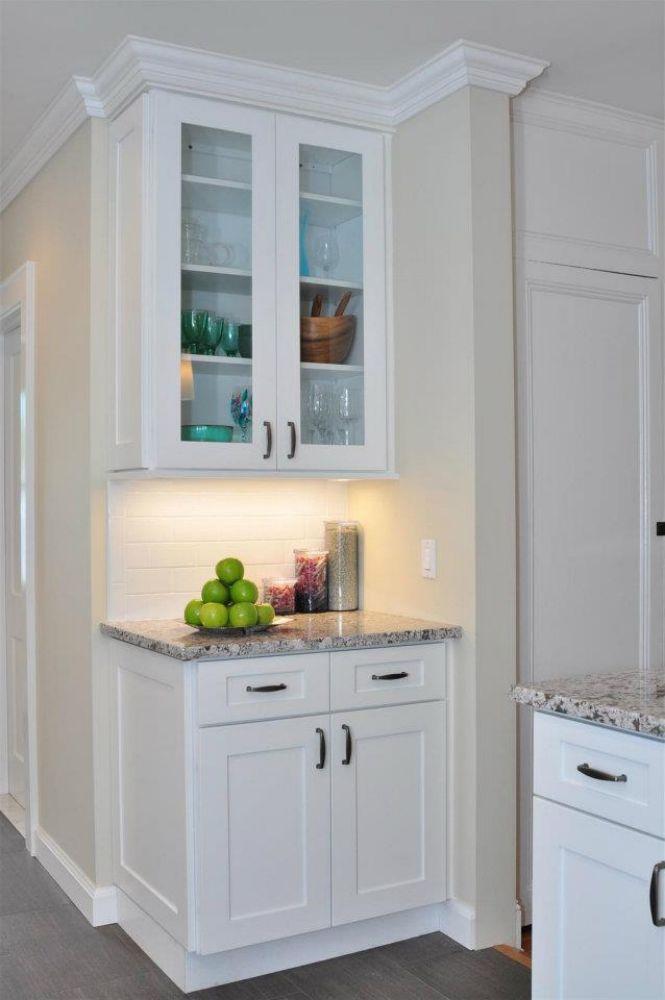The Growing Demand for Non-Toxic Finishes in Modern Cabinetry
Homeowners today are more conscious than ever about the materials used in their living spaces. Beyond aesthetics and craftsmanship, the focus has shifted toward safety, sustainability, and health. Among the most important considerations is how wood cabinetry is finished—especially when it comes to the types of coatings, stains, and sealants applied to protect and enhance the wood.
Traditional finishes often contain volatile organic compounds (VOCs), solvents, and formaldehyde-based chemicals that release harmful fumes into the air, compromising indoor air quality and potentially affecting health. As a result, many homeowners are now seeking non-toxic finishes for wood cabinets, which offer both beauty and safety without the environmental or health risks.
The best examples of this commitment to healthy living can be found in certified cabinetry, such as those offered under the Non-toxic finishes for wood cabinets category by My Kitchen Cabinets. These cabinets are designed with finishes that meet the most stringent Greenguard Gold standards, ensuring clean indoor air and long-term durability.
Understanding What Makes a Finish Non-Toxic
A non-toxic finish is one that contains little to no harmful chemicals or VOCs. VOCs are compounds that easily evaporate at room temperature, releasing gases into the air. These emissions contribute to indoor air pollution and can cause headaches, nausea, allergies, and respiratory irritation.
Non-toxic finishes eliminate or drastically reduce these compounds, making them safer for families, pets, and the environment. They are typically water-based, plant-derived, or mineral-based rather than petroleum-based, and they contain minimal synthetic solvents.
To be classified as non-toxic, a wood finish must meet established safety standards such as Greenguard Gold, Green Seal, or low-VOC requirements outlined by the Environmental Protection Agency (EPA).
The Impact of Traditional Finishes on Indoor Air Quality
Traditional cabinet finishes, while durable and attractive, can negatively impact indoor air quality. Oil-based polyurethane, lacquer, and varnish, for example, often release VOCs and formaldehyde during both application and curing.
These emissions don’t just disappear after drying. Off-gassing can continue for months or even years, especially in enclosed spaces like kitchens and bathrooms where airflow is limited.
The result is long-term exposure to low levels of harmful chemicals, which can lead to respiratory issues, skin irritation, and allergic reactions. Non-toxic finishes for wood cabinets solve this issue by offering protection and luster without compromising air quality.
Key Ingredients in Non-Toxic Finishes for Wood Cabinets
Non-toxic finishes rely on safer, natural ingredients that provide both beauty and protection. Some common components include:
-
Water: Serves as a solvent in water-based finishes, replacing harmful chemical solvents.
-
Natural Oils: Such as linseed, tung, hemp, or walnut oil, which penetrate the wood and provide a protective layer.
-
Natural Waxes: Beeswax or carnauba wax offers a soft sheen and water resistance.
-
Mineral Pigments: Derived from clay or earth minerals for natural coloration.
-
Resins and Polymers: Plant-based or bio-based materials used to enhance hardness and durability.
These components create finishes that are biodegradable, sustainable, and safe for application in both residential and commercial environments.
Types of Non-Toxic Finishes for Wood Cabinets
There are several types of non-toxic finishes for wood cabinets, each offering a different level of sheen, protection, and maintenance. Understanding their characteristics can help homeowners choose the right finish for their space.
1. Water-Based Finishes
Water-based polyurethane and acrylic finishes are among the most popular non-toxic options. They emit very low VOCs and dry quickly, creating a clear, durable coating that resists yellowing over time.
2. Natural Oil Finishes
Finishes made from linseed, tung, or hemp oil penetrate deeply into the wood fibers, enhancing the natural grain while providing water and stain resistance. They are easy to apply and recoat but may require periodic maintenance.
3. Wax Finishes
Beeswax and carnauba wax finishes create a soft, velvety sheen that accentuates the wood’s natural texture. While not as protective as polyurethane, they are completely safe and ideal for cabinetry in low-moisture environments.
4. Shellac Finishes
Derived from natural resin secreted by the lac bug, shellac is a time-tested finish known for its quick-drying properties and warm, glossy appearance. When dissolved in alcohol with minimal additives, it qualifies as a non-toxic option.
5. Plant-Based Finishes
These include blends made from citrus oils, linseed, and beeswax. Plant-based finishes are eco-friendly and non-toxic, ideal for homes seeking both sustainability and style.
The Benefits of Using Non-Toxic Finishes for Wood Cabinets
Switching to non-toxic finishes provides numerous advantages, not only for health but also for aesthetics and the environment.
1. Improved Indoor Air Quality
Low- and zero-VOC finishes drastically reduce chemical emissions, leading to cleaner, fresher indoor air.
2. Healthier Living Environments
Families with children, pets, or allergy sufferers benefit greatly from finishes that don’t off-gas harmful fumes.
3. Eco-Friendly Production
Non-toxic finishes are made from renewable resources and natural ingredients, supporting sustainable manufacturing.
4. Aesthetic Versatility
These finishes highlight the natural beauty of wood, enhancing its grain and color without artificial gloss or tint.
5. Long-Term Durability
Contrary to common misconceptions, non-toxic finishes can be just as resilient as traditional coatings when properly applied.
6. Compliance with Green Building Standards
Products finished with non-toxic materials often qualify for green building programs such as LEED, WELL, or BREEAM.
How Non-Toxic Finishes Enhance the Lifespan of Cabinets
While their main appeal lies in health and safety, non-toxic finishes also contribute to the longevity of cabinetry. Water-based and oil-based natural finishes penetrate and seal the wood, creating a barrier against moisture and wear.
They help prevent cracking, warping, and staining without forming thick surface films that can peel or chip over time. Moreover, these finishes are easy to maintain—allowing homeowners to refresh the coating periodically without sanding or refinishing the entire surface.
This balance of protection and renewability makes non-toxic finishes an excellent long-term investment.
The Role of Certification in Verifying Non-Toxic Finishes
Certification plays a crucial role in validating the safety of non-toxic finishes. Manufacturers seeking credibility must submit their products for third-party testing to ensure they meet strict emission and environmental standards.
Programs such as Greenguard Gold certification evaluate products for chemical emissions and indoor air quality performance. Cabinets that carry this certification, like those from My Kitchen Cabinets, guarantee that their finishes emit extremely low levels of VOCs and other pollutants.
Certified products also support green construction initiatives, helping builders and homeowners earn points toward sustainable building certifications.
Comparing Non-Toxic and Conventional Finishes
| Feature | Conventional Finish | Non-Toxic Finish |
|---|---|---|
| VOC Emissions | High | Very Low to None |
| Drying Time | Moderate to Long | Quick (Water-based) |
| Odor | Strong chemical smell | Mild or odorless |
| Durability | High (some solvent-based) | High (depending on formulation) |
| Maintenance | Requires refinishing | Easy to refresh |
| Health Impact | May cause irritation | Safe for all users |
| Environmental Impact | Petroleum-based chemicals | Renewable and biodegradable ingredients |
This comparison highlights why non-toxic finishes for wood cabinets are rapidly becoming the preferred choice among environmentally conscious consumers and professional designers.
Choosing the Right Non-Toxic Finish for Your Cabinets
Selecting the best non-toxic finish depends on the desired look, usage, and maintenance preferences.
-
For high-use areas like kitchens and bathrooms, opt for water-based polyurethane for maximum protection.
-
For natural aesthetics, use tung or linseed oil to enhance the grain without a glossy film.
-
For a soft luster, beeswax or carnauba wax finishes provide a classic, hand-rubbed look.
-
For fast-drying applications, choose shellac, which offers quick sealing and easy touch-ups.
Professional guidance from manufacturers such as My Kitchen Cabinets ensures that your chosen finish aligns with both style and safety expectations.
How Non-Toxic Finishes Contribute to Sustainability
Non-toxic finishes align perfectly with sustainable living goals. Their low-impact production methods reduce waste, minimize pollution, and use renewable raw materials.
Additionally, because these finishes are biodegradable, they have less environmental impact at the end of their lifecycle. Many non-toxic coatings are also produced using energy-efficient processes, further reducing the carbon footprint associated with cabinetry manufacturing.
By choosing these finishes, homeowners not only protect their health but also contribute to a cleaner and more sustainable planet.
The Connection Between Non-Toxic Finishes and Greenguard Gold Cabinets
The Greenguard Gold certification is the benchmark for low-emission cabinetry. Products that meet this certification undergo extensive laboratory testing to verify they emit minimal pollutants into the indoor environment.
Cabinets with Greenguard Gold-certified finishes, such as those offered by My Kitchen Cabinets, represent the ideal combination of safety, quality, and sustainability. They are suitable for sensitive settings such as nurseries, schools, and healthcare environments, where clean air is essential.
The integration of non-toxic finishes in certified cabinets ensures both environmental responsibility and superior craftsmanship.
Maintenance Tips for Non-Toxic Finished Cabinets
Proper maintenance ensures that non-toxic finishes continue to perform well and retain their appearance for years.
-
Use gentle cleaners – Mild soap and water are sufficient for regular cleaning. Avoid harsh chemicals or abrasives.
-
Wipe spills immediately – Prevent moisture damage by cleaning spills promptly.
-
Reapply natural oils or waxes periodically – Helps restore luster and protection.
-
Avoid prolonged exposure to sunlight – UV rays can discolor certain natural finishes.
-
Keep humidity balanced – Maintain a stable indoor environment to prevent wood expansion or contraction.
By following these care tips, homeowners can preserve both the finish and integrity of their wood cabinets for decades.
The Future of Non-Toxic Finishes for Wood Cabinets
The cabinetry industry is evolving rapidly toward cleaner and safer production practices. As technology advances, manufacturers are developing new formulas that improve performance while maintaining non-toxic integrity.
Emerging innovations include:
-
Bio-based resins and coatings derived from renewable plant materials.
-
UV-cured finishes that eliminate chemical solvents entirely.
-
Nano-enhanced natural oils for superior scratch resistance.
-
Water-based pigment systems that deliver vibrant color without synthetic dyes.
These advancements ensure that non-toxic finishes remain at the forefront of sustainable home design and construction.
Conclusion
The shift toward non-toxic finishes for wood cabinets marks a new era in home design—one that values health, sustainability, and responsible craftsmanship as much as aesthetics. By eliminating harmful VOCs and synthetic chemicals, these finishes create safer environments where families can thrive.
From water-based polyurethanes to natural oils and waxes, non-toxic finishes offer durability, beauty, and peace of mind. When paired with Greenguard Gold-certified cabinetry, they represent the gold standard in modern, eco-friendly interior design.
Choosing non-toxic finishes isn’t just about style—it’s about making a conscious decision to protect your family and the planet. In doing so, homeowners can enjoy elegant, long-lasting wood cabinetry that truly enhances the quality of life.

